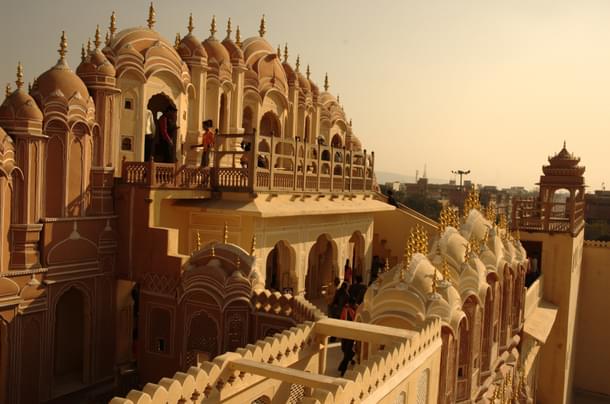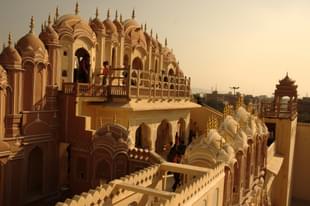Magazine
What Indian Tourism Is, And What Indian Tourism Can Be
Kamalpreet Singh Gill
Apr 01, 2019, 09:48 PM | Updated 09:48 PM IST
Save & read from anywhere!
Bookmark stories for easy access on any device or the Swarajya app.


In 2017, 10.04 million foreign tourists arrived in India, generating earnings of $27.31 billion. Those sound like very impressive numbers until you consider the fact that globally, India was only the twenty-sixth most-visited destination in the world. The tiny island of Macau receives more foreign tourists than India. The city of Barcelona alone receives about as many foreign tourists annually as all of India.
More numbers to ponder upon — with 86.9 million arrivals in 2017, more people visit France than any other place in the world. At $210 billion the United States earns the most from foreign tourist arrivals — nearly 10 times than what India does. At the risk of repeating a cliche, India is one of the most diverse countries on the planet, both culturally and geographically. Four of the world’s 35 biodiversity hotspots lie fully or partially in India. India is also home to 37 UNESCO World Heritage Sites, the fifth largest number after China, Italy, Spain, France and Germany.
Why then are not more people coming to visit the wonders that India has to offer? And why should we be concerned about it? The answer — money and soft power.
The Economics Of Tourism
The numbers for the tourism industry are big, yet easily overlooked. In 2018, the sector generated $240 billion or 9.2 per cent of India’s gross domestic product (GDP) in revenue. It also supported 42.673 million jobs or 8.1 per cent of India’s total employment. The tourism sector is the third highest forex earner for the Indian economy. Despite all this, the sector doesn’t appear to be very high on the government’s priorities. The World Economic Forum’s (WEF) Travel & Tourism Competitiveness report ranks India a dismal 40 out of a total of 136 countries — an indication that there is tremendous room for improvement. The WEF estimates that increasing India’s foreign tourist arrivals to 20 million from the present 10 million can lead to an additional tourism receipts of $20 billion.
As compared to many other similarly-sized economies, India has a smaller percentage of its GDP coming from tourism. The figure stands at 21 per cent for Thailand, 15 per cent for Spain, 11 per cent for China and 9.2 per cent for India. Source: World Travel & Tourism Council, 2017.
Tourism And Soft Power
Soft power is defined as the ability to influence the behaviour of international actors and achieve strategic foreign policy objectives through the attractiveness of your culture and values. Two very important yardsticks on which soft power is measured are the number of international visitors coming to a country and the number of foreign students choosing to study there. This is what explains why countries like Spain, Italy and Portugal wield considerable soft power despite being relative non-entities in international politics.
The 2017, soft power 30 report ranks France — the most visited country on the planet — at number 2 on its Soft Power 30 Index, just behind the UK. The index, prepared annually by the University of Southern California Center on Public Diplomacy, and Portland, a consultancy firm working with governments is considered a benchmark by governments and businesses around the world. Professor Joesph Nye, who pioneered the concept of soft power, calls this index ‘the cleanest picture of global soft power to date’. The methodology used for arriving at the rankings uses the number of international tourist arrivals as well as the ability of a country to attract foreign students as key parameters. Needless to say, India does not figure in the top 30, although Belgium, Poland, the Czech Republic and Argentina do.
In upper middle class drawing rooms in Delhi and Mumbai, it is not uncommon for conversations to revolve around the best time to visit Mont-Saint-Michel, budget hotels on the French Riviera, or the must-see cafes in Paris. Drop in the name of a Janjira Fort and one would likely draw blanks (for those who don’t know, the Murud-Janjira fort off the Konkan coast is a seventeenth century island fortress much like the fabled Mont St-Michel in France, except Janjira was never conquered). More Indians today know about types of French Wines than the bewildering varieties of Indian heritage liquors ranging from the exotic Mahansar wines of Rajasthan that are exported worldwide to the rice brews of Sikkim.
One can imagine then, the power (or the lack of it) on the world stage of a nation whose culture remains largely unknown to its own people, leave alone the rest of the world. At a time when opinions are formed at a safe distance thanks to technology, most of which is controlled by the First World, and when opinions drive domestic and foreign policy, who will speak in defence of a Third World culture except one who has experienced it? The recent coverage of Pulwama terror attack and Balakot airstrikes in the international media is an example of how global perceptions are shaped by media and tech giants who know little about the culture of regions they are reporting on.
Meanwhile, generations of Francophiles are created in India and abroad thanks to travel bucket lists with Paris at the top. This is a measure of the soft power that France still wields, a few centuries after it stopped being of much consequence in world affairs.
To be sure, soft power alone is of little consequence. Coupled, however, with economic and military clout it can be potent. On the other hand, an economic and military behemoth with little soft power can end up appearing like a grumpy lonesome bully on the world stage. Think Russia.
The lesson for India is simple — if it wants to be taken seriously on the world stage, it must convince more people to come and see it.
So what’s holding us back then? A host of issues — some old culprits and some that are unique to the tourism sector.
Infrastructure
Infrastructure in the form of good roads and connectivity is recognised as a major bottleneck for many sectors of the economy. While highways have significantly improved over the last few decades, connectivity to rural areas and more off-beat locations still leaves a lot to be desired.
Specifically for the tourism industry, a major infrastructural bottleneck is the availability of hotels. Despite the explosion of home grown startups like Oyo, India faces a terrible shortage of hotel rooms. According to the Federation of Hotel and Restaurant Association of India, by 2015 India only had 100,000 hotel rooms in all categories. Compare to this to Bangkok city, which had 125,000 hotel rooms in that year and New York City which boasted of 80,000. Such an acute shortage invariably drives up the costs of accommodation in India besides affecting the quality of services, as compared to its rivals in the neighbourhood. By 2020, India would need to triple the number of hotel rooms to stay competitive.
Pollution
This is one of the biggest challenges that can disrupt the growth of India’s tourism sector. The number of Indian cities that feature on the world’s most polluted lists is alarming and is going to scare tourists away. This needs to be tackled on a war footing to ensure that the sector isn’t affected.
Safety
India’s reputation as being the most dangerous country on the planet for women has been in the headlines for a few years now. It’s a fact that just needs to be accepted. The tourism industry relies to a great extent on perception. And with news of sexual assaults and mob lynchings hogging media space, a lot of people are not going to feel very comfortable visiting a place they think their families might not feel very safe in.
Red Tape
Tourists often report getting a visa to India as still being a cumbersome process laden with excessive red tape and documentation. Recent initiatives such as e-Visa extension of ‘Visa on Arrival’ to cover more nationalities have helped remedy this to some extent, however the fact remains that India is not considered a very tourist-friendly country.
Harnessing India’s Tourism Potential, Now
Tourism doesn’t have to be culturally invasive or environmentally damaging. On the contrary, it can act as a catalyst to help preserve rapidly vanishing heritage. A visit to rural Rajasthan underscores this. Tourism is one of the most important contributors to the state’s economy, making up over 15 per cent of its GDP. Enterprising rural elites have converted their crumbling ancestral homes into boutique hotels called Rawlas that now dot the Rajasthani countryside. Thanks to some innovative marketing, busloads of foreign tourists are now a common site in Rajasthani villages with concomitant economic benefits accruing to rural households, who also get an added incentive to preserve their heritage, which would otherwise have got trampled under the onslaught of modernity.
For instance, not many know that the camel, the state animal of Rajasthan is on the verge of extinction. Improved roads and modern transportation have made the once ubiquitous ship of the desert redundant. However, tourist attractions such as the Pushkar Camel Fair have ensured that the camel survives, even if only for the sake of visitors. Meanwhile, a German conservationist who fell in love with Rajasthan during one of her visits has started a rural Camel Conservation Centre that is attempting to preserve the way of life of Rajasthan’s ancient camel herding communities.
There is no reason why other Indian states cannot take a leaf out of Rajasthan’s book. The world over tourism is known to benefit local communities, who usually do not have access to other tools of social mobility. It’s a sector that is friendly to the small entrepreneur, the low-skilled worker, and cottage industries.
India’s tourism potential is immense — being about five times the size of France, and having far greater cultural and geographical diversity — there is no reason why it should not be able to draw as many, if not more tourists than France. The question of whether the Eiffel Tower is more deserving of human admiration than the Taj Mahal or the ruins of Hampi is best left to exponents and practitioners of cultural warfare. But at a time when there is an increased awareness in India to present Indic values and the Indic world view as an alternative to both the Anglo-Saxon and the Chinese civilisational system, the first thing we need is to open our doors to the travellers of the world for them to experience firsthand all that India stands for. If it also helps us to generate income to lift millions out of poverty, shouldn’t we be doing more to promote tourism?
Kamalpreet Singh Gill is a regular contributor to Swarajya. His areas of interest include history, politics, and strategic affairs. He tweets at @KPSinghtweets.




